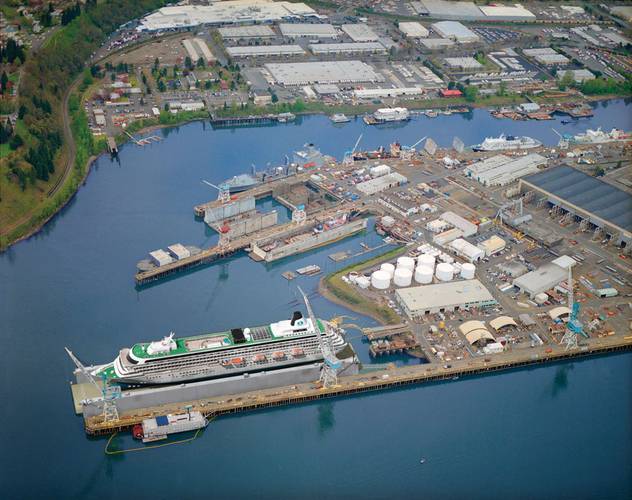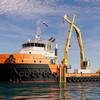Shipbuilding: Vigor Industrial Grows Stronger
Vigor Industrial has ballooned from a modest shipyard in Portland, Oregon, to the largest shipbuilder in the Pacific Northwest and Alaska.
Vigor increasingly thinks big and builds big. The company’s new floating dry dock will be the largest in the United States. And Vigor wants to get even bigger. CEO and owner Frank Foti expresses an ambition to grow to twice the current size in the “next few years.” Foti, who is also chairman of the Shipbuilder’s Council of America, says he is, “striving for critical mass. That means being the right size financially and geographically, and developing the right mix of business lines and capabilities to move out of the boom and bust cycle of the typical shipyard business. Proof is in the results,” he continues, “our fabrication team has a growing backlog at a time when industry analysts are predicting flat or shrinking backlogs.”
To make it in a highly competitive global industry, Vigor offers the full range of services; including new build and repair, conversions, outfitting and modernization. Beyond this, the company does marina and land-based fabrication, industrial and marine coatings, plus machining services. Joe Covelli, Senior Vice President of Fabrication, says that in addition to these, Vigor is setting its sights on “moving up stream, developing our design, planning and engineering teams to work with customers earlier and earlier in the design process.”
Location, Location, Location
Vigor has multiple shipyards, half a billion dollars in annual revenue and 2,000 employees who build tugs, barges, workboats, cargo ships, fishing vessels and ferries. It has seven loading facilities, ten dry-docks, 17,000 feet of dedicated pier space and half a million square feet of covered shop area. Vigor fabricates large projects like bridge supports and wave energy platforms and also works on all kinds of ships. It made safety and environmental upgrades to the semi-submersible drill rig Kulluk and drillship Noble Discoverer before they set sail for rough Arctic waters in 2012. According to Vigor, the firm works on more vessels in the Coast Guard fleet than any other company.
Vigor’s facilities stretch from Portland, Oregon to Seward, Alaska. A 60-acre shipyard is located in Portland, another 27 acres on Harbor Island in Seattle, 16 acres in Ketchikan and 11 more acres in Seward. Vigor teams also work in the Navy shipyards in Bremerton and Everett. There is a smaller facility, Washington Marine Repair, in Port Angeles, Washington. Of the two shipyards in Alaska, one is in Ketchikan at the south end of the wet panhandle and one is farther north in Seward on the Kenai Peninsula.
Vigor’s recent acquisition of Seward Ship’s Drydock improves the company’s ability to work on vessels from the fishing, oil and gas industry as well respond to expected increases in demand linked to Arctic drilling. The company is accustomed to working on vessels deployed in the cold North Pacific, Bering Sea and Gulf of Alaska.
With yards located from Oregon to Alaska, there is plenty of opportunity to cross-pollinate between operations, find efficiencies and work on design changes earlier in the planning process.
Covelli says that each shipyard is training to do more than in the past. “Portland is a good example, where our teams are learning best practices and deploying experts from across the company to grow from simpler barges to more complex barges to now self-propelled vessels,” he says.
CEO Frank Foti founded Vigor -- its name chosen for its connotations of energy and power – in 1995, when he took proceeds from selling a family-owned construction company in Cleveland, Ohio and bought the Cascade General shipyard in Portland, Oregon. By 2011, Vigor Industrial was buying Todd-Pacific Shipyards, a leading West Coast builder of ferries and repairer of Navy ships, and a company nearly Vigor’s same size.
The Vigor companies include Vigor Fab (formerly US Fab), Vigor Shipyards, Vigor Industrial, Specialty Finishes, Vigor Marine, Vigor Machine, Vigor Alaska, Specialty Finishes, Washington Marine Repair and Shipyard Commerce Center. There have been enough name-changes that the company’s brochures haven’t kept up with them.
New Projects, Healthy Backlog, and Workboats, too
Vigor has several new projects in the pipeline: river tugs, very large barges and ferries among them. Two 422-foot tank barges of articulated tug and barge configurations will be some of the largest vessels constructed for Harley Marine’s fleet. The “state-of-the-art,” double-hulled fuel barges will be built at the Portland yard. Vigor is also building a 242-foot split-hull hopper barge with an advanced sealing mechanism to safeguard environmentally sensitive areas from potential leakage.
In the Seattle area, historically the place where ferries have been built, the company is finishing a 362-foot state ferry, the Tokitae, to carry 144 cars and 1500 people. Vigor has a contract for two of the ferries, plus there is the possibility of a third. In 2011, Vigor finished three 64-car ferries for Washington State. With a planned cost of $213 million, the ferries came in almost $7 million under budget, with a total cost of $206 million.
Foti and his company don’t shy from trying something new, as illustrated by Vigor’s contract, just underway, to build three new tugs with Tidewater Barge Lines of Vancouver, Washington. The future Columbia-Snake River pushboats will be built in Portland instead of Seattle.
Says Foti, “Building tugs in Portland is a sign that Vigor is evolving as a business. In the past, our different locations had different fabrication specialties: barges in Portland, ferries in Seattle and fishing boats and ferries in Alaska. Rather than be content with that, we’ve worked hard to share knowledge and talent between all of our locations.”
Horses for Courses
The Tidewater tugs, which will be 102 feet long each and designed for the Columbia-Snake River system began, says the naval architect, as an ordinary project. Corning Townsend, of CT Marine in Edgecomb, Maine, is a specialist in river towboats and highly loaded propellers. “The project seemed to be quite ordinary (relative to other 4400’s for the Mississippi River),” he writes in an email, “so I sketched a conceptual design of what we thought might be a solution and headed West for a visit.”
Townsend began riding Tidewater tugs up and down the Columbia. “It was immediately obvious that the differences between the barges pushed, the river and the ambient weather made the new towboat unlike any we had done in the past 40 years for river in the East.”
Some locks on the Columbia are 100 feet deep; so the first thing he decided to do was extend the main engine exhaust pipes nearly 60 feet above the engines so that when in the lock chamber, the ambient air would be breathable for the crew.
Next, he noticed that the variety of barges pushed on the Columbia have a much larger range of drafts and freeboards than on the Mississippi, so he changed the location and path of the push wires used to steer and stop the barge fleet. And as Townsend rode Tidewater’s barges on the river, he got a big surprise.
“There were times when we went less than half a mile upstream in 60 minutes due to extreme current. There were other times when we needed to top the tow against 70 MPH winds. When I asked the captain if this was normal, his reply was: ‘if we can’t operate in 70 MPH winds, we would never leave the dock.’
“On the Mississippi,” Townsend says, “all towboats would be tied to the bank if such a wind occurred. This pointed out the need for very high thrust and extraordinary steering ability for the new boats. Consequently we included the CT-28 nozzles around each propeller and two steering rudders behind each nozzle. The towboat is also fitted with 4 flanking rudders two ahead of each the propellers, each pair with independent differential linkage.”
Vigor’s Joe Corvelli calls the tugboats “a perfect example of evolution in progress. Our in-house production engineering teams worked with the customer, their designers and engineers to create fully developed, well-engineered designs with our production process and facilities in mind.
“The idea is that this upfront engineering will pay off with efficiencies throughout the three-vessel build project. All the pieces are there and you know how they fit,” he says. “For example, when you know where every piece goes, you can paint components earlier in the workflow, ideally while in modules are still under roof, with the confidence that you won’t have the risk of doing lots of rework because the part doesn’t fit or you need to make an entirely new piece.”
In a press release, Tidewater calls the tugs “state-of-the-art vessels. The new tugs have a deeper draft, are taller and have more engine horsepower for the length of boat in order to most efficiently traverse the eight navigational locks on the CSR [Columbia-Snake River] system,” Tidewater writes. “With their unique double-hulled design, no potable water, fuel, or lubricants will be adjacent to the hull, further increasing the safety and environmental factors built into the design. Additionally, the vessel design features ergonomic accommodations and comforts proven to minimize fatigue and reduce injuries amongst crew.”
A Wide Menu
In addition to building vessels, Vigor repairs and modernizes all kinds of vessels. Spokesperson Brian Mannion reports that Vigor has more than 30 repair projects underway across locations, ranging from small fishing vessels to Navy Destroyers and U.S. Navy Military Sealift Command supply ships.
For instance, Vigor retrofitted the 97-foot Chief Seattle fireboat. It also replaced the 300-ton bow of Olympic Spirit, a double hull petroleum barge owned by Harley Marine subsidiary, Olympic Tug & Barge, Inc. See the time-lapse video at http://vigorindustrial.com/vigor-marine/projects#olympic_spirit_bow_replacement. Vigor is a shipyard with its own YouTube channel.
For the Navy, Vigor has worked on the massive aircraft carrier USS Lincoln, which is 1,092 feet long by 257 feet wide at the flight deck, more than once. The company also services the USS Nimitz aircraft carrier based in Everett, Washington.
On the Coast Guard side, Vigor finished $56 million in maintenance and modernization efforts for the heavy icebreaker Polar Star, 399 feet, to return it to service at the end of 2012. Vigor does routine and emergent maintenance for vessels in the USCG fleet, including National Security Cutters, high and medium endurance cutters and the buoy tender fleet.
Balancing Act: No Problem for Vigor
Construction funds linked to government work are about as placid and dependable as the Bering Sea. Says Foti. “At best, the government is looking at reductions in defense spending. At worst, we’ll keep seeing made-up crises like sequestration and unpredictable government shutdowns. The shipbuilding and repair industry is a $20 billion industry. About 60 percent of that is government work, with the balance being commercial shipbuilding and repair.”
To counteract the uncertainties, Vigor is working to acquire non-shipbuilding business. Its website says, “Vigor companies can fabricate just about any steel structure regardless of shape, size or complexity.” Vigor fashioned eight 25-metric ton bridge bracing cubes for the Portland-Milwaukie Light Rail Bridge on the Willamette River. It is producing 153-foot-long wave buoy platforms to capture renewable energy from ocean waves. Vigor constructs precision metal platforms to turn methane gas from landfill garbage into electricity in South America and other locations.
Sheer size helps even out workloads and use of skilled workers. Keeping people employed is “more than just a feel-good issue for us,” says spokesperson Brian Mannion, “It’s a competitiveness issue.” Vigor must retain the best people by keeping a steady flow of work.
As MarineNews went to press, Vigor was about to take possession of the largest floating dry-dock in the United States. At 960 feet long, 300 feet longer and one-and-a-half times wider than anything Vigor already has, it will be large enough to service Military Sealift Command dry cargo/ammunition ships and private vessels including post-Panamax cargo ships and cruise ships. The increased capacity will also help Vigor meet growing demand from the Arctic as oil and gas exploration and other ship operators take advantage of longer ice-free summers.
Frank Foti says, “It’s more than an investment. It’s a symbol of the resurgence of the industry. Back in 2000, we sold off a nearly identical dry-dock to stabilize the business. At that time, the shipyard only had a few hundred people working and a lot of debt. When that dry-dock left, a lot of people predicted it would be the end of the shipyard in Portland. Today, we have 700 people working at the yard and a growing business strong enough to buy the largest dry-dock in the country and put it to good use.” In today’s robust boatbuilding environment, then, Vigor has indeed “Gone Big.”
(As published in the April 2014 edition of Marine News - www.marinelink.com)














